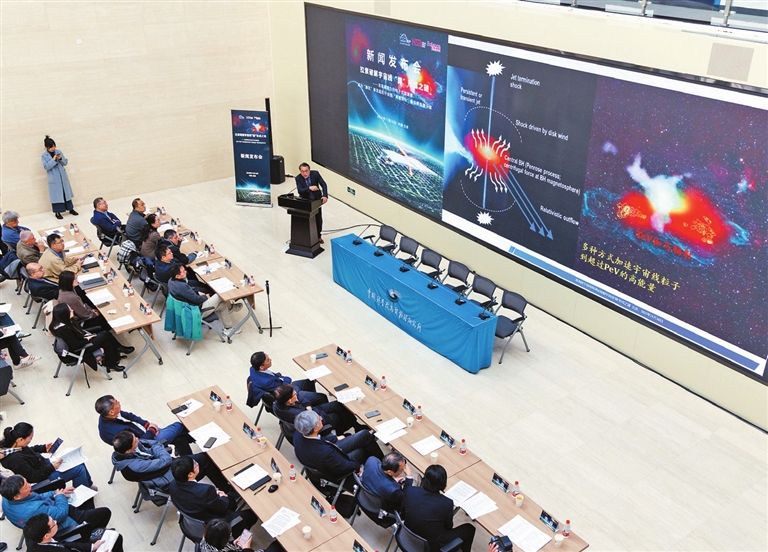
A JOINT team of Chinese and international scientists released the latest research results from China's Large High Altitude Air Shower Observatory (LHAASO) on Sunday. The findings shed new light on a decades-old mystery concerning the cosmic ray energy spectrum, which exhibits a sharp decline — known as the "knee" — above 3 peta-electronvolts (PeV). The origin of the "knee," first observed nearly 70 years ago, has long puzzled scientists. It has been hypothesized that this feature reflects the acceleration limit of cosmic ray sources and marks a transition between two power-law distributions in the energy spectrum. Two studies — published in National Science Review and Science Bulletin, respectively — reveal that micro-quasars powered by black hole accretion are potent particle accelerators within the Milky Way and are likely responsible for the "knee." These findings also enhance our understanding of the extreme physical mechanisms in black hole systems, according to the Institute of High Energy Physics at the Chinese Academy of Sciences (CAS). Black holes, among the most mysterious objects in the universe, produce jets approaching the speed of light as they accrete matter from companion stars in binary systems, forming micro-quasars. In this research, LHAASO systematically detected ultra-high-energy gamma rays from five such micro-quasars for the first time. The results indicate that the primary cosmic rays producing these gamma rays likely reach energies beyond 1 PeV and even 10 PeV — surpassing the energy threshold of the "knee." This resolves a long-standing challenge, as previously recognized cosmic ray sources such as supernova remnants could not exceed this limit, either observationally or theoretically. To further investigate this phenomenon, precise measurements of the energy spectra of various cosmic ray species and their respective "knee" regions are essential. However, due to the scarcity of cosmic rays in this energy range and interference from Earth’s atmosphere, distinguishing protons from other atomic nuclei has been extremely difficult— and was once considered nearly impossible. Leveraging LHAASO’s multiparameter measurement techniques, the research team obtained a large, high-purity proton sample with accuracy comparable to satellite-based experiments. This revealed an unexpected new structure in the energy spectrum, clearly indicating a previously unknown "high-energy component." Combined with low- and intermediate-energy components measured by space-borne experiments, LHAASO’s results demonstrate the presence of multiple cosmic ray accelerator populations in the Milky Way, each with distinct acceleration capabilities and energy ranges. The "knee" marks the upper acceleration limit of the sources generating the high-energy component. These two breakthroughs are mutually reinforcing, forming a coherent scientific narrative. They not only represent a major step toward solving the long-standing puzzle of the "knee," but also provide key observational evidence for understanding the role of black holes in cosmic ray origins. According to Cao Zhen, a CAS academician and chief scientist of LHAASO, the facility’s hybrid detector design enables the detection of cosmic ray sources via ultra-high-energy gamma rays, while also allowing precise measurement of cosmic ray particles near the solar system. For the first time, the "knee" structure has been observationally linked to a specific class of astrophysical source: black hole jet systems. Cao said that an estimated dozen or so such sources exist in our galaxy. Cao added that the acceleration mechanisms of some artificial particle accelerators resemble those of cosmic ray accelerators in space. Deeper understanding of these processes could inform the development of next-generation particle accelerators. Located at 4,410 meters above sea level on Mount Haizi in Daocheng, Sichuan Province, LHAASO is a ground-based cosmic ray observatory designed, built, and operated by Chinese scientists. It leads the world in high-energy cosmic ray research, thanks to its high sensitivity in both gamma-ray astronomy and cosmic ray spectroscopy, and has produced a series of influential discoveries — advancing humanity’s understanding of extreme physical processes in the universe.(SD-Agencies) | 
